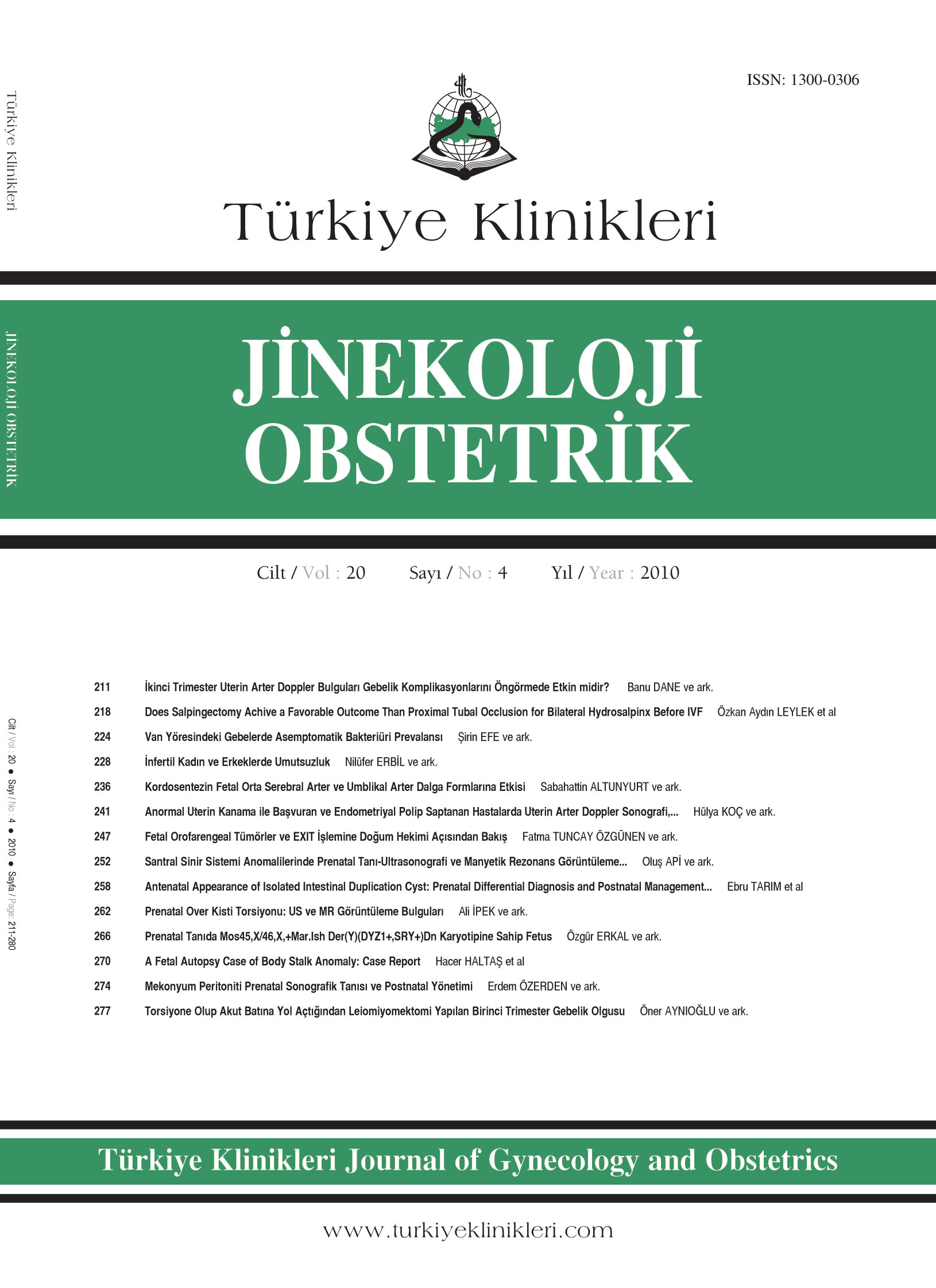Open Access
Peer Reviewed
CASE REPORTS
4423 Viewed1153 Downloaded
Prenatal Sonographic Diagnosis and Postnatal Management of Meconium Peritonitis: Case Report
Mekonyum Peritoniti Prenatal Sonografik Tanısı ve Postnatal Yönetimi
Turkiye Klinikleri J Gynecol Obst. 2010;20(4):274-6
Article Language: TR
Copyright Ⓒ 2025 by Türkiye Klinikleri. This is an open access article under the CC BY-NC-ND license (http://creativecommons.org/licenses/by-nc-nd/4.0/)
ÖZET
Mekonyum peritoniti, gastrointestinal sistem perporasyonu nedeniyle gelişen nadir bir durumdur. Sekonder inflamatuar yanıta bağlı olarak sıvı (asit), fibrozis, kalsifikasyon ve bazen kist oluşumu gelişebilir. Mekonyum peritonitinin tanısı prenatal ultrason incelemesi ile mümkün olabilir. Yaygın bulguları şunlardır: intraabdominal kalsifikasyonlar, asit, intraabdominal kitleler, bağırsak dilatasyonu, polihidroamniyos ve mekonyum kistleri. Biz prenatal dönemde tanı konulmuş olan mekonyum peritonitli bir yenidoğan olgusunu sunduk. Doğumdan hemen sonra, bebekte solunum sıkıntısı gelişti ve entübe edildi. Batın ileri derece şişkindi; karın duvarı ödemli ve eritemliydi. Bebeğe acil laparotomi uygulandı ve distal ileal atrezi ile birlikte proksimal ileal perforasyon tespit edildi. İleal segment parsiyel rezeksiyonu ve ileostomi uygulandı. Postoperatif dönem problemsiz oldu. Prenatal sonografi mekonyum peritonit şüphesi olan bebeklerin doğumu ve uygun yönetimi için tersiyer bir merkeze transferine olanak sağlar.
Mekonyum peritoniti, gastrointestinal sistem perporasyonu nedeniyle gelişen nadir bir durumdur. Sekonder inflamatuar yanıta bağlı olarak sıvı (asit), fibrozis, kalsifikasyon ve bazen kist oluşumu gelişebilir. Mekonyum peritonitinin tanısı prenatal ultrason incelemesi ile mümkün olabilir. Yaygın bulguları şunlardır: intraabdominal kalsifikasyonlar, asit, intraabdominal kitleler, bağırsak dilatasyonu, polihidroamniyos ve mekonyum kistleri. Biz prenatal dönemde tanı konulmuş olan mekonyum peritonitli bir yenidoğan olgusunu sunduk. Doğumdan hemen sonra, bebekte solunum sıkıntısı gelişti ve entübe edildi. Batın ileri derece şişkindi; karın duvarı ödemli ve eritemliydi. Bebeğe acil laparotomi uygulandı ve distal ileal atrezi ile birlikte proksimal ileal perforasyon tespit edildi. İleal segment parsiyel rezeksiyonu ve ileostomi uygulandı. Postoperatif dönem problemsiz oldu. Prenatal sonografi mekonyum peritonit şüphesi olan bebeklerin doğumu ve uygun yönetimi için tersiyer bir merkeze transferine olanak sağlar.
ABSTRACT
Meconium peritonitis is a rare condition due to perforation of gastrointestinal tract. A secondary inflammatory response results in the production of fluid (ascites), fibrosis, calcification and sometimes cyst formation. The diagnosis of meconium peritonitis is possible by prenatal ultrasound examination. Common findings include: intra abdominal calcifications, ascites, intra abdominal masses, bowel dilatation, polyhydramnios and meconium cysts. We report a newborn infant with prenatal sonographic diagnosis of meconium peritonitis. Immediately after birth, the baby developed severe respiratory distress and was intubated. The abdomen was severely distended; the abdominal wall was edematous and erythematous. The baby underwent emergency laparotomy and proximal ileal perforation was identified with distal ileal atresia. Partial resection of the ileal segment and ileostomy was performed. The postoperative course was uneventful. Prenatal sonography allows suspected meconium peritonitis babies to be transferred to a tertiary centre for delivery and appropriate management.
Meconium peritonitis is a rare condition due to perforation of gastrointestinal tract. A secondary inflammatory response results in the production of fluid (ascites), fibrosis, calcification and sometimes cyst formation. The diagnosis of meconium peritonitis is possible by prenatal ultrasound examination. Common findings include: intra abdominal calcifications, ascites, intra abdominal masses, bowel dilatation, polyhydramnios and meconium cysts. We report a newborn infant with prenatal sonographic diagnosis of meconium peritonitis. Immediately after birth, the baby developed severe respiratory distress and was intubated. The abdomen was severely distended; the abdominal wall was edematous and erythematous. The baby underwent emergency laparotomy and proximal ileal perforation was identified with distal ileal atresia. Partial resection of the ileal segment and ileostomy was performed. The postoperative course was uneventful. Prenatal sonography allows suspected meconium peritonitis babies to be transferred to a tertiary centre for delivery and appropriate management.
MENU
POPULAR ARTICLES
MOST DOWNLOADED ARTICLES





This journal is licensed under a Creative Commons Attribution-NonCommercial-NoDerivatives 4.0 International License.










